Damage Assessment of Porcelain Insulators through Principal Component Analysis Associated with Frequency Response Signals
Abstract
1. Introduction
2. Materials and Methods
2.1. Test Specimen
2.2. Frequency Response Function (FRF)
2.3. Principal Component Analysis (PCA)
2.4. Test Methods
3. Results and Discussion
3.1. Basic Experiment Analysis and Results
3.2. Frequency Response Analysis Results
3.3. Principal Component Analysis Results
4. Conclusions
Author Contributions
Funding
Conflicts of Interest
References
- Looms, J.S.T. Introduction. In Insulators for High Voltages, 7th ed.; Peter Peregrinus Ltd.: London, UK, 1988; pp. 1–3. [Google Scholar]
- Choi, I.H.; Kim, T.K.; Yoon, Y.B.; Kim, T.Y.; Nguyen, H.T.; Yi, J.S. A Study on the Life-Time Assessment Ways and Various Failure Types of 154 kV Porcelain Insulators Installed in South Korea. Trans. Electr. Electron. Mater. 2018, 19, 188–194. [Google Scholar] [CrossRef]
- Ostendorp, M. Assessing the integrity and remaining service life of vintage high voltage ceramic insulators. In Proceedings of the 2003 IEEE 10th International Conference on Transmission and Distribution Construction, Operation and Live-Line Maintenance, Orlando, FL, USA, 6–10 April 2003; pp. 169–175. [Google Scholar]
- Vaillancourt, G.H.; Carignan, S.; Jean, C. Experience with the detection of faulty composite insulators on high-voltage power lines by the electric field measurement method. IEEE Trans. Power Deliv. 1998, 13, 661–666. [Google Scholar] [CrossRef]
- Volat, C.; Jabbari, M.; Farzaneh, M.; Duvillaret, L. New method for in live-line detection of small defects in composite insulator based on electro-optic E-field sensor. IEEE Trans. Dielectr. Electr. Insul. 2013, 20, 194–201. [Google Scholar] [CrossRef]
- Padma, V.; Raghavan, V.S. Analysis of insulation degradation in Insulators using Partial Discharge analysis. In Proceedings of the 2011 3rd International Conference on Electronics Computer Technology, Kanyakumari, India, 8–10 April 2011; pp. 110–114. [Google Scholar]
- Park, K.C.; Motai, Y.C.; Yoon, J.R. Acoustic fault detection technique for high-power insulators. IEEE Trans. Ind. Electron. 2017, 64, 9699–9708. [Google Scholar] [CrossRef]
- Cherney, E.A.; Amm, D.E. Development and application of a hot-line suspension insulator tester. IEEE Trans. Power Appar. Syst. 1981, PAS-100, 1525–1528. [Google Scholar] [CrossRef]
- Ha, H.; Han, S.; Lee, J. Fault detection on transmission lines using a microphone array and an infrared thermal imaging camera. IEEE Trans. Instrum. Meas. 2012, 61, 267–275. [Google Scholar] [CrossRef]
- Kim, T.Y.; Jeon, S.H.; Lee, Y.J.; Yi, J.S.; Choi, I.H.; Son, J.A.; Choi, C.W. Three-Dimensional Computed Tomography and Composition Analysis of Porcelain Insulators for 154-kV Power Transmission Lines. IEEE Trans. Dielectr. Electr. Insul. 2019, 26, 115–119. [Google Scholar] [CrossRef]
- Miao, X.R.; Liu, X.Y.; Chen, J.; Zhuang, S.B.; Fan, J.W.; Jiang, H. Insulator Detection in Aerial Images for Transmission Line Inspection Using Single Shot Multibox Detector. IEEE Access 2019, 7, 9945–9956. [Google Scholar] [CrossRef]
- Auckland, D.W.; McGrail, A.J.; Smith, C.D.; Varlow, B.R.; Zhao, J.; Zhu, D. Application of ultrasound to the inspection of insulation. IEE Proc. Sci. Meas. Technol. 1996, 143, 177–181. [Google Scholar] [CrossRef]
- Wong, K.L. Application of the Very-high Frequency (VHF) Method to Ceramic Insulators. IEEE Trans. Dielectr. Electr. Insulm. 2004, 1, 1057–1064. [Google Scholar] [CrossRef]
- Park, J.Y.; Cho, B.H.; Byun, S.H.; Lee, J.K. Development of Robot System for Automatic Cleaning and Inspection of Live-line Suspension Insulator Strings and Its Application. J. Korean Soc. Precis. Eng. 2007, 24, 66–75. [Google Scholar]
- Miletiev, R.; Simeonov, I.; Iontchev, E.; Yordanov, R. Time and frequency analysis of the vehicle suspension dynamics. Int. J. Syst. Appl. Eng. Dev. 2013, 7, 287–294. [Google Scholar]
- Miyazaki, S.; Mizutani, Y.; Taguchi, A.; Murakami, J.; Tsuji, N.; Takashima, M.; Kato, O. Diagnosis Criterion of Abnormality of Transformer Winding by Frequency Response Analysis (FRA). Electr. Eng. Jpn. 2017, 201, 25–34. [Google Scholar] [CrossRef]
- Sano, T.; Miyagi, K. Experimental investigation on FRA diagnosis of transformer faults. IEEJ Trans. Power Energy 2007, 127, 791–796. [Google Scholar] [CrossRef][Green Version]
- Ryder, S.A. Diagnosing transformer faults using frequency response analysis. IEEE Electr. Insul. Mag. 2003, 19, 16–22. [Google Scholar] [CrossRef]
- Christain, J.; Feser, K. Procedures for detecting winding displacements in power transformer by the transfer function method. IEEE Trans. Power Deliv. 2004, 19, 214–220. [Google Scholar] [CrossRef]
- Miyazaki, S.; Mizutani, Y.; Matsumoto, K.; Nakamura, S. On-Site Diagnosis of Transformer Winding by Frequency Response Analysis. IEEJ Trans. Power Energy 2010, 130, 451–459. [Google Scholar] [CrossRef]
- Li, J.C.; Dackermann, U.; Xu, Y.L.; Samali, B. Damage identification in civil engineering structures utilizing PCA-compressed residual frequency response functions and neural network ensembles. Struct. Control Health Monit. 2011, 18, 207–226. [Google Scholar] [CrossRef]
- Zhang, G.; Tang, L.Q.; Zhou, L.C.; Liu, Z.J.; Liu, Y.P.; Jiang, Z.Y. Principal Component Analysis Method with Space and Time Windows for Damage Detection. Sensors 2019, 19, 2521. [Google Scholar] [CrossRef]
- Pearson, K. On lines and planes of closest fit to systems of points in space. In The London, Edinburgh and Dublin Philosophical Magazine and Journal of Science, 6th ed.; Taylor and Francis: London, UK, 1901; Volume 2, pp. 559–572. [Google Scholar]
- Hotelling, H. Analysis of a complex of statistical variables into principal components. J. Educ. Psychol. 1933, 24, 417–441. [Google Scholar] [CrossRef]
- Jolliffe, I.T. Principal Component Analysis, 2nd ed.; Springer Science & Business Media: New York, NY, USA, 2002; pp. 1–27. [Google Scholar]
- Tharwat, A. Principal component analysis-a tutorial. IJAPR 2016, 3, 197–240. [Google Scholar] [CrossRef]
- Stoica, P.; Moses, R. Introduction to Spectral Analysis, 1st ed.; Prentice Hall: Ann Arbor, MI, USA, 1997; pp. 52–54. [Google Scholar]
- ES (Technical Standards of KEPCO). Testing Methods for Insulators; Korea Electric Power Corporation: Daejeon, Korea, 2014. [Google Scholar]
- Anjum, S.; Jayaram, S.; El-Hag, A.; Naderian, A. Radio frequency (RF) technique for field inspection of porcelain insulators. In Proceedings of the 2015 IEEE 11th International Conference on the Properties and Applications of Dielectric Materials (ICPADM), Sydney, NSW, Australia, 19–22 July 2015; pp. 1019–1022. [Google Scholar]
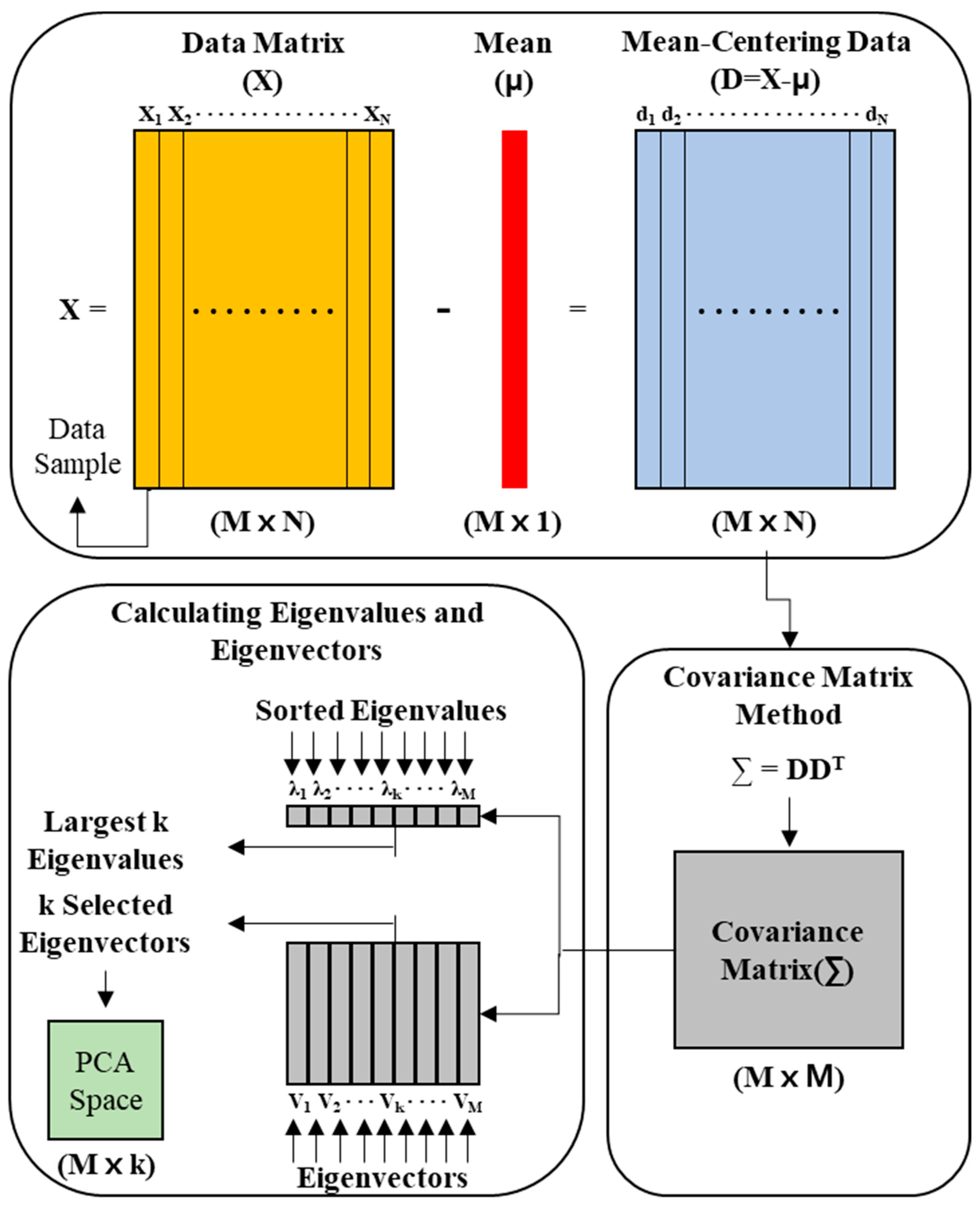
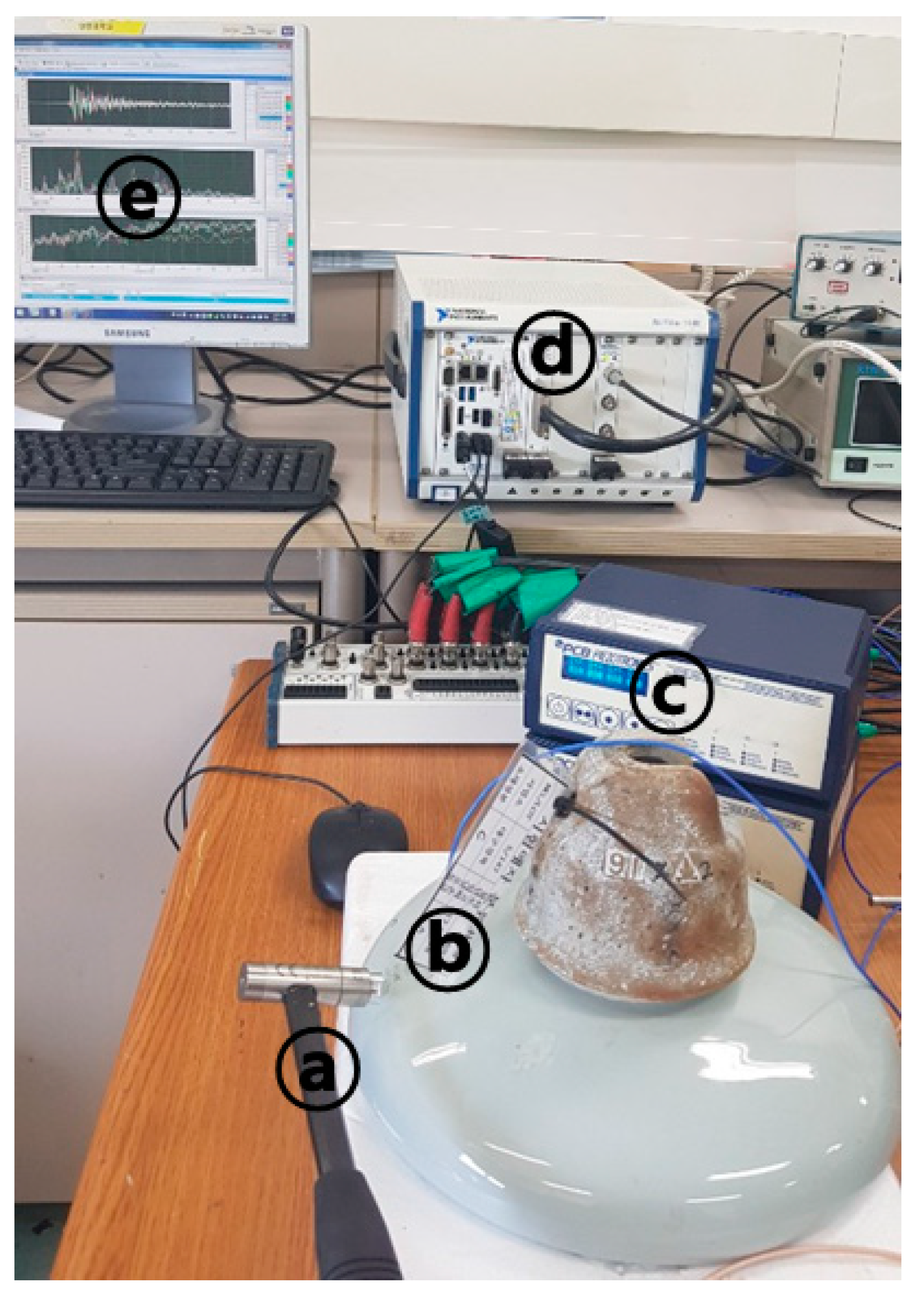
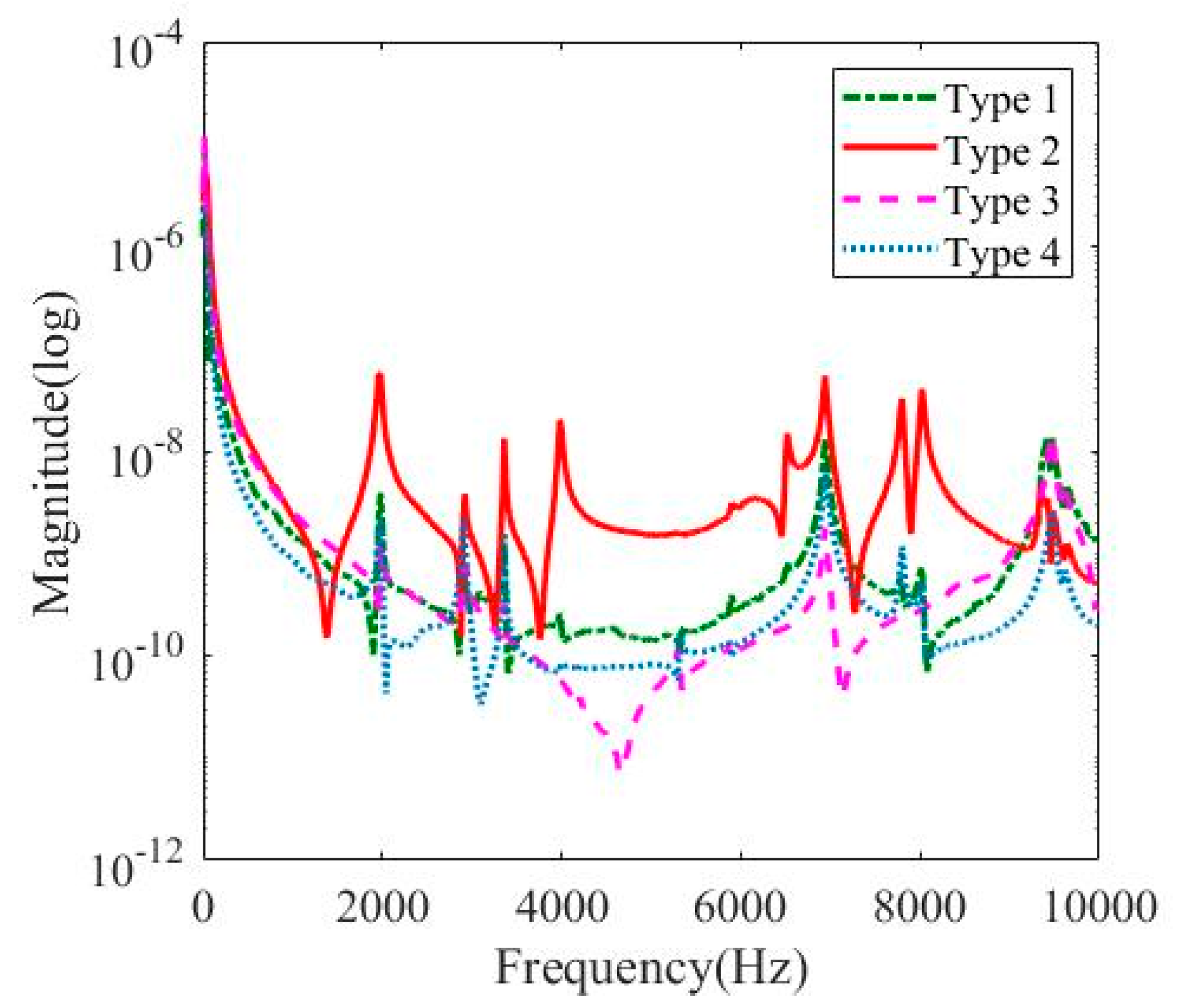
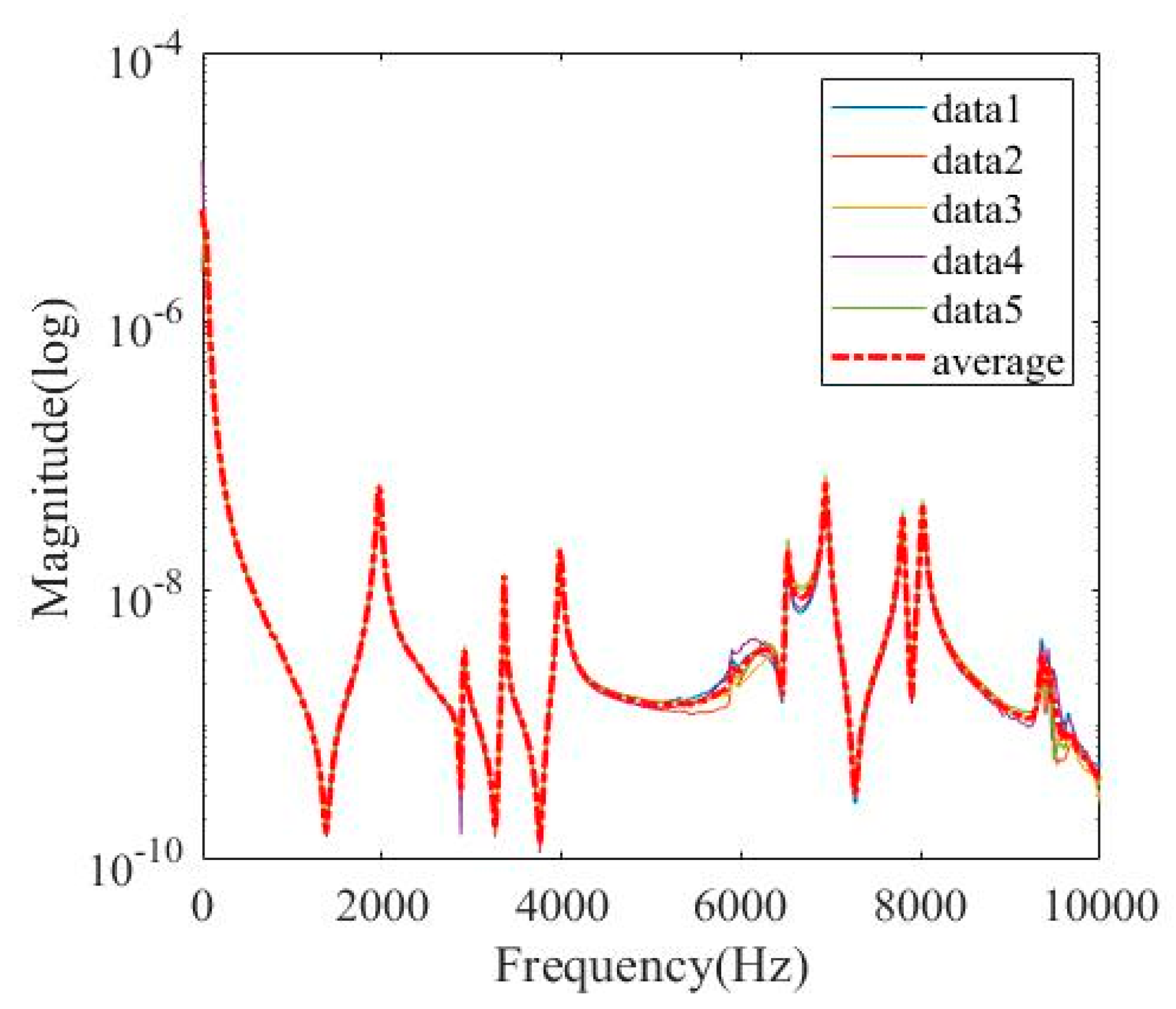
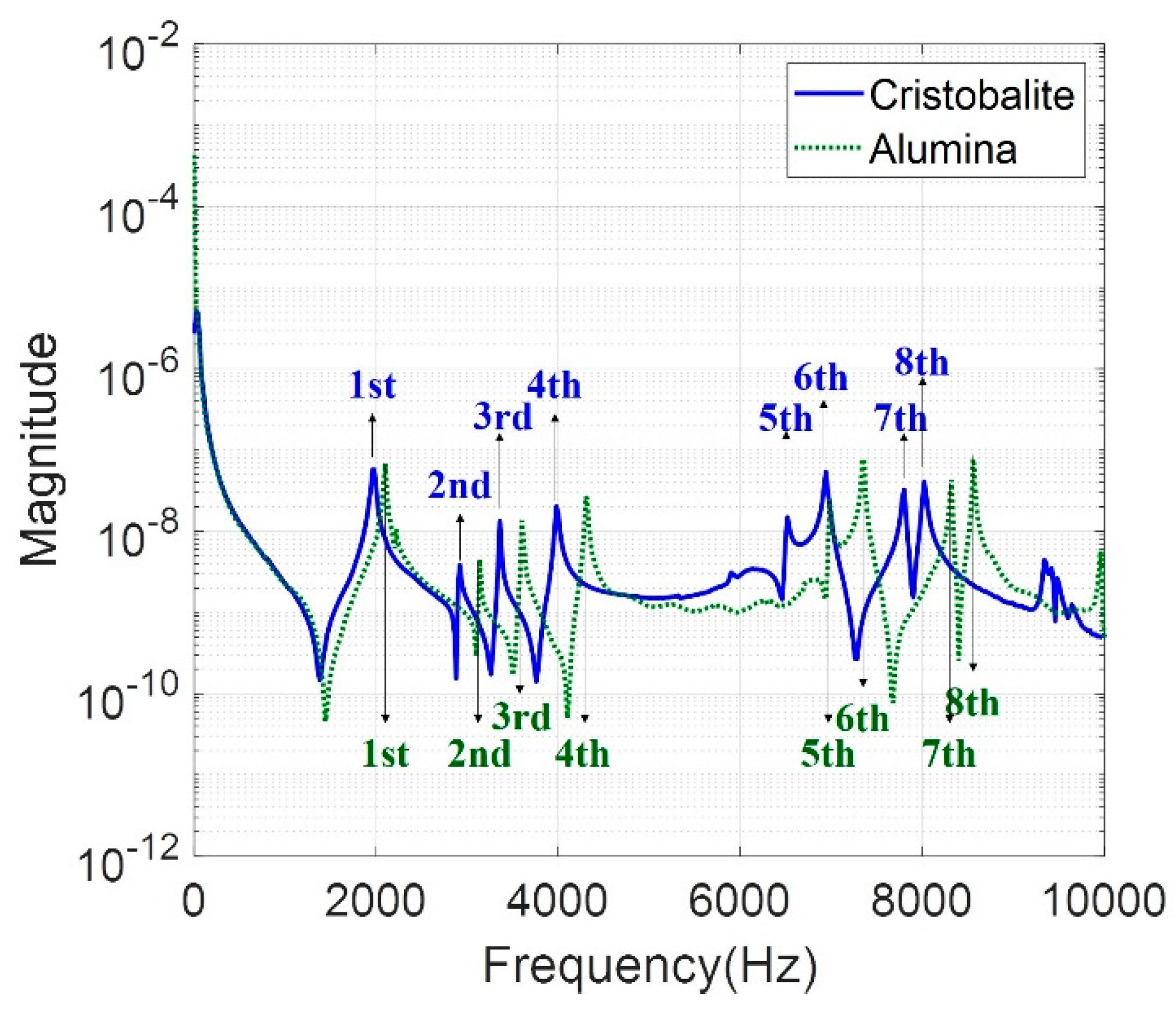

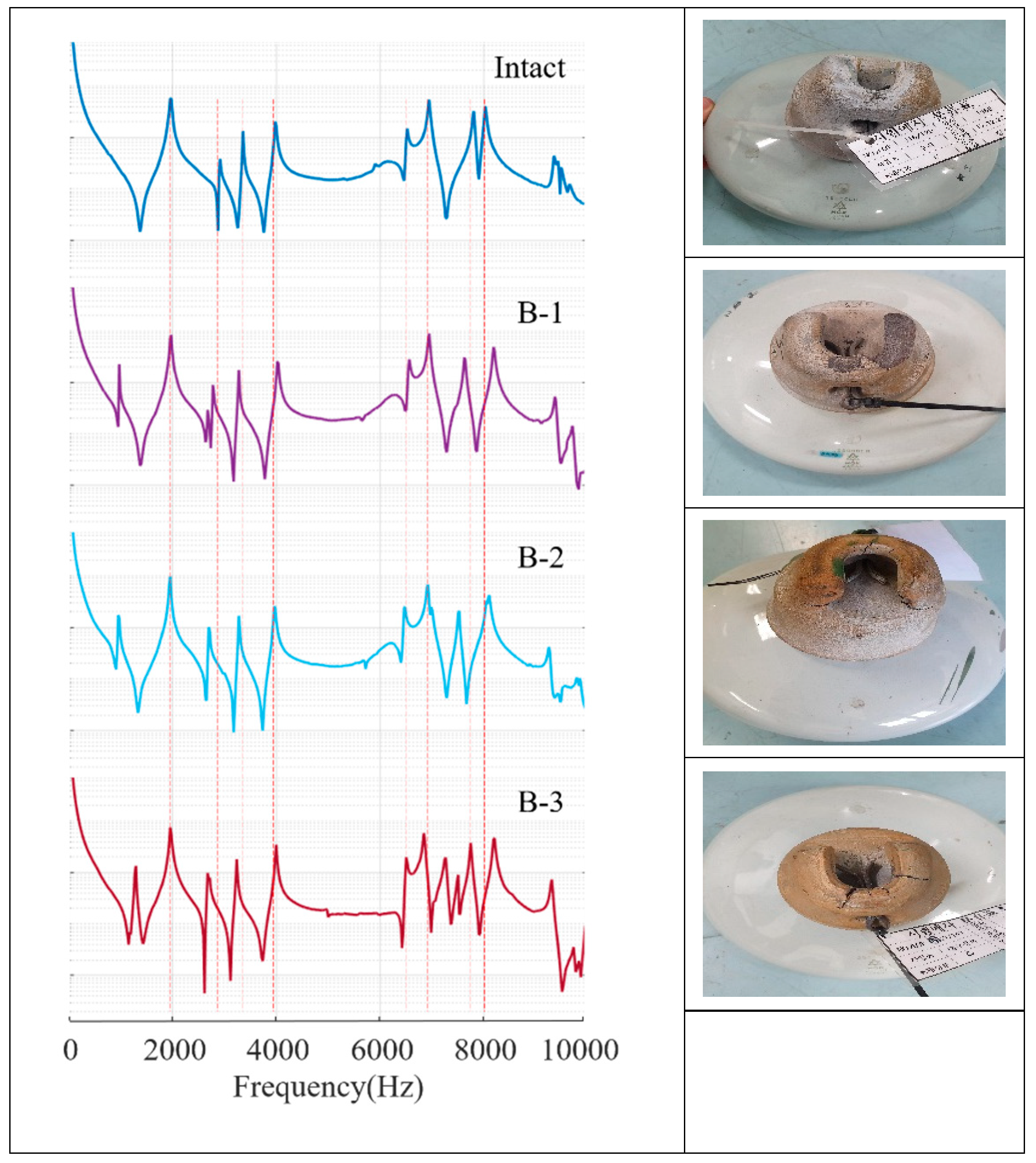
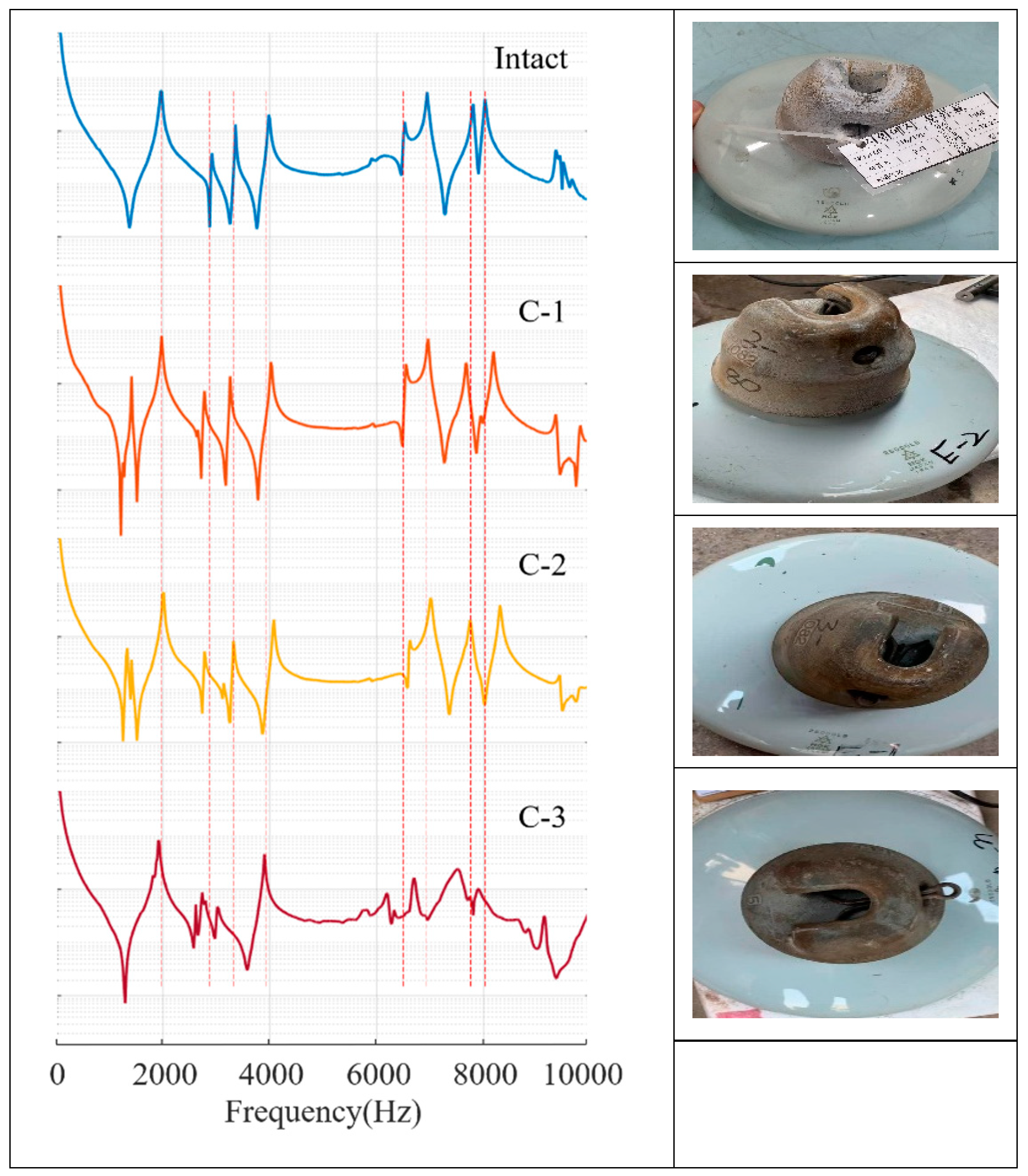
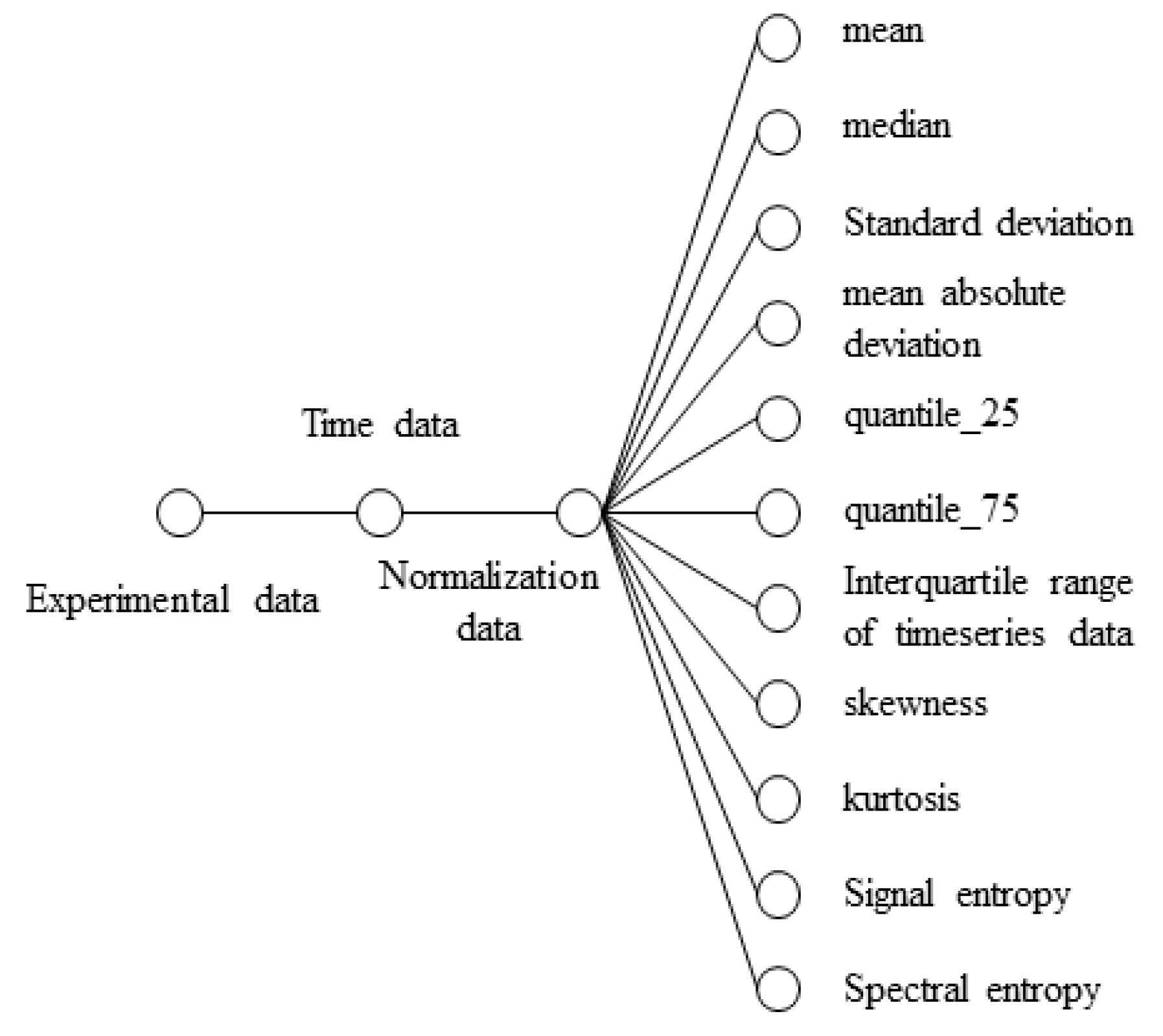
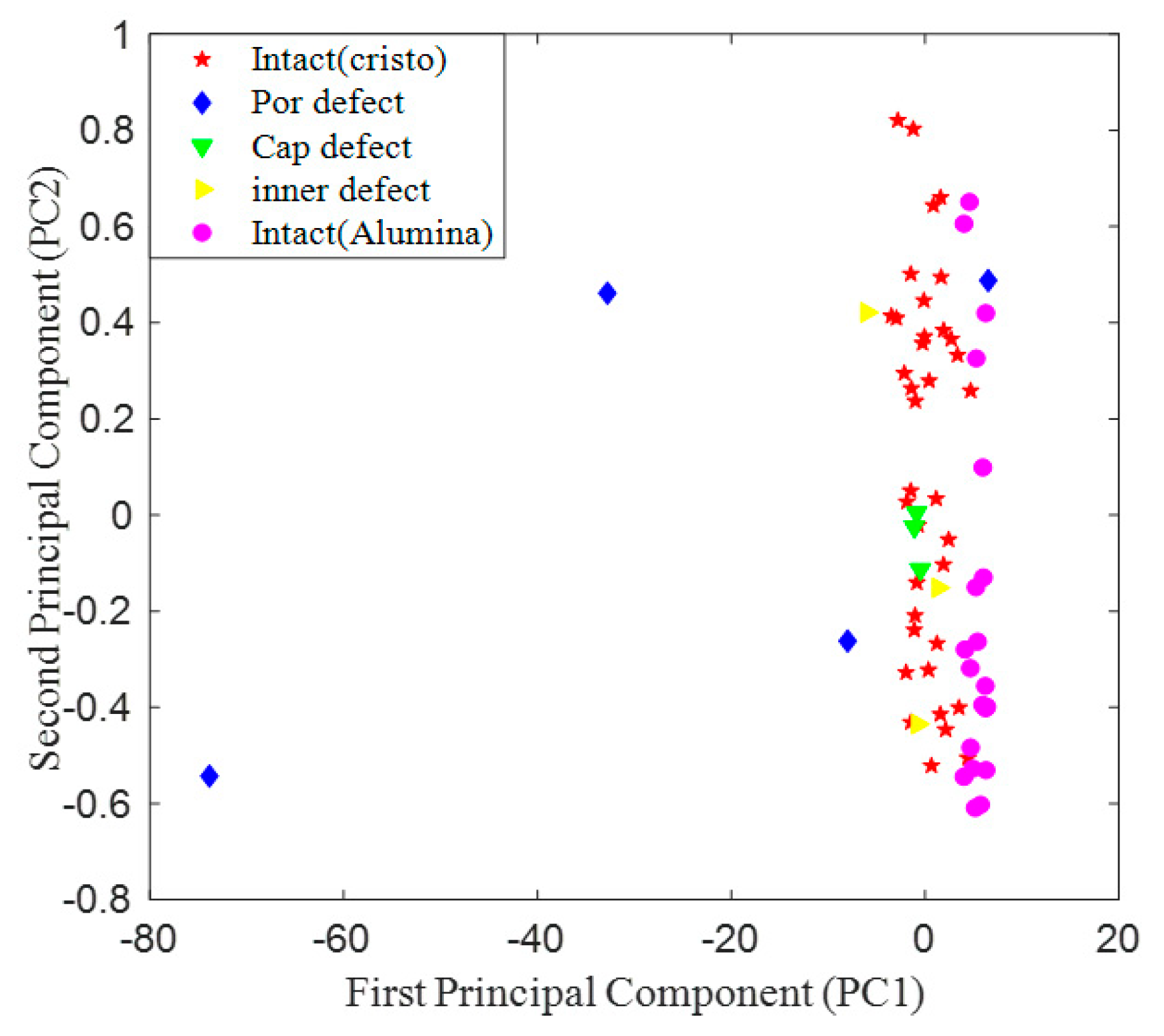
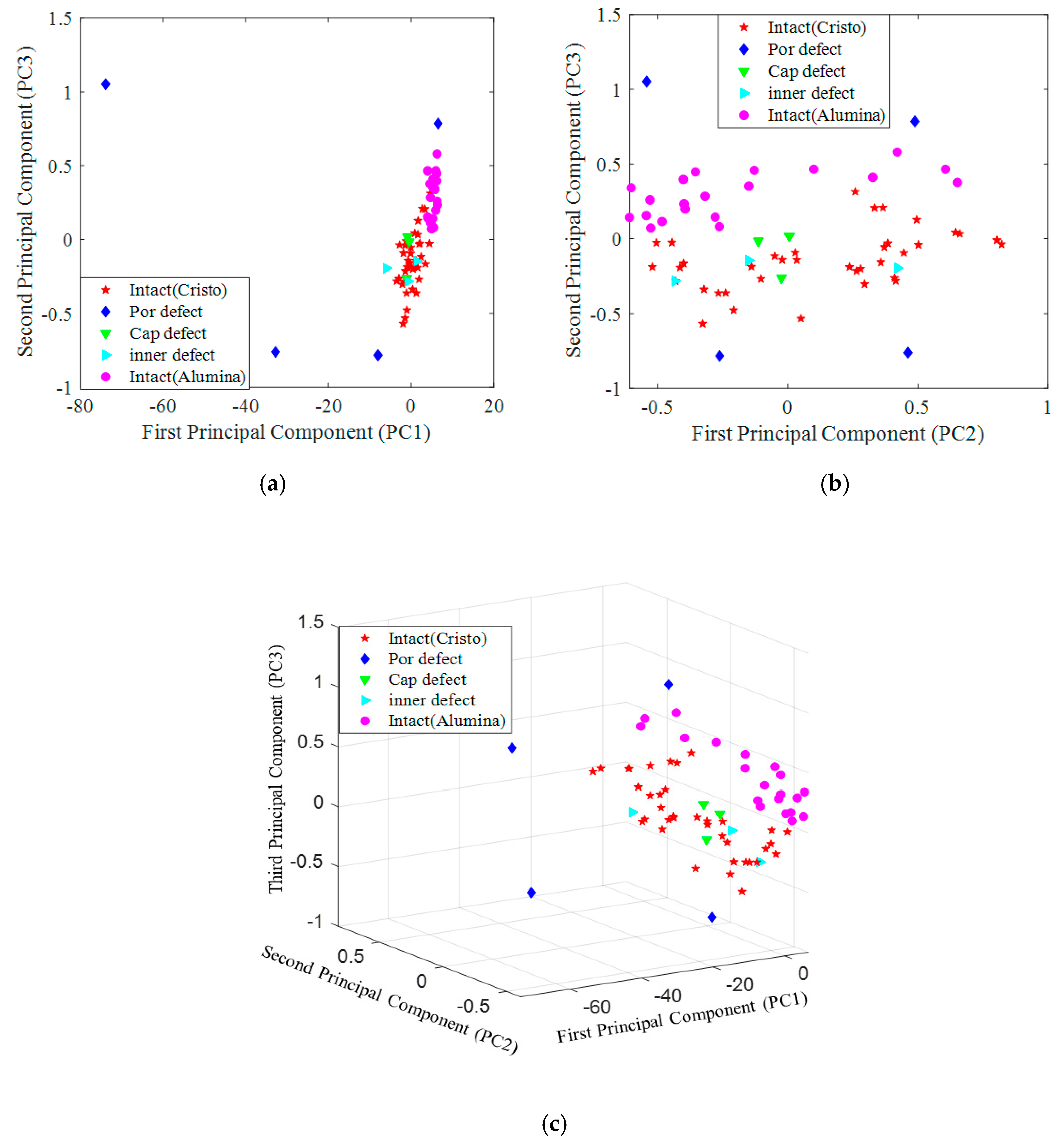
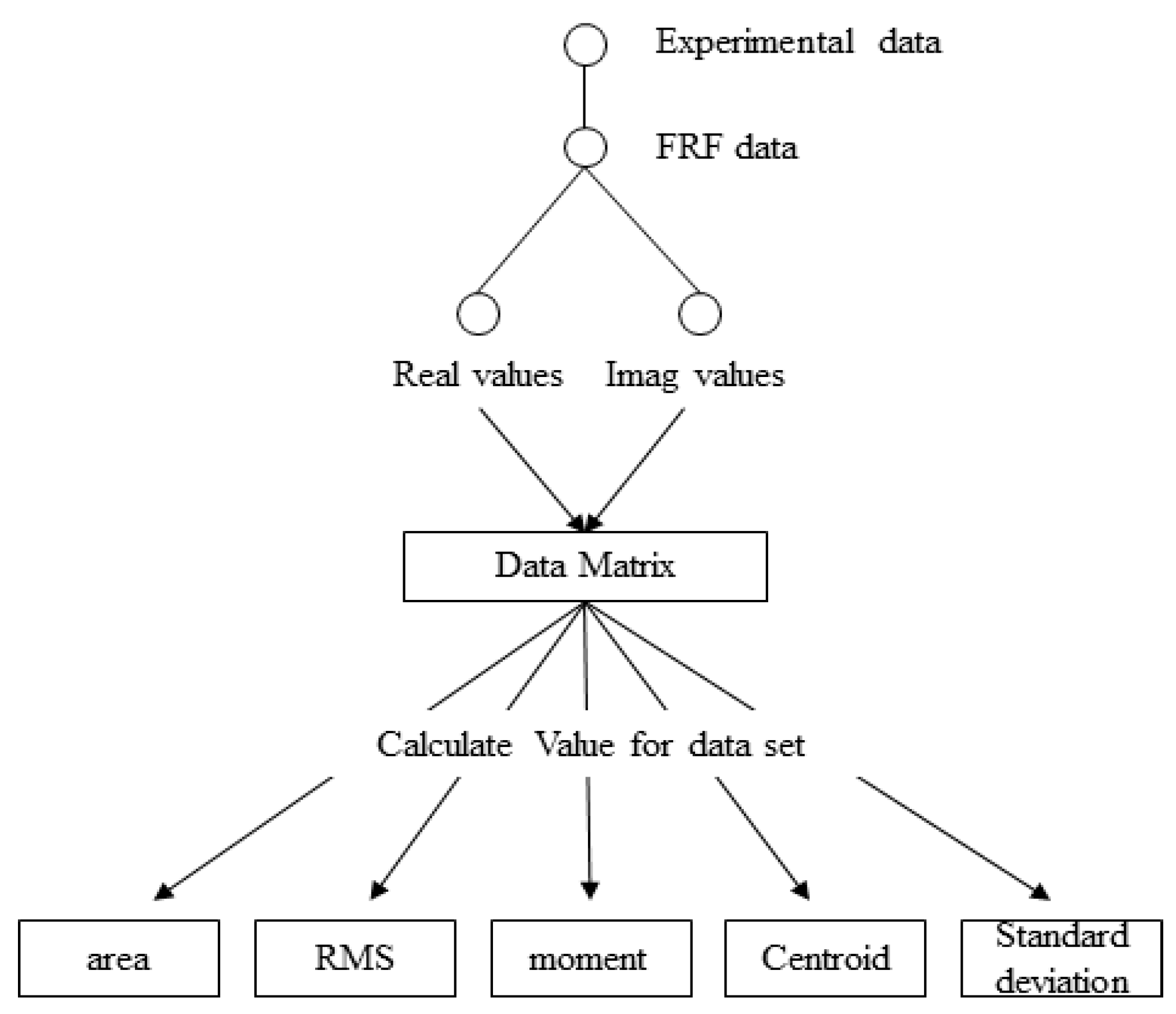
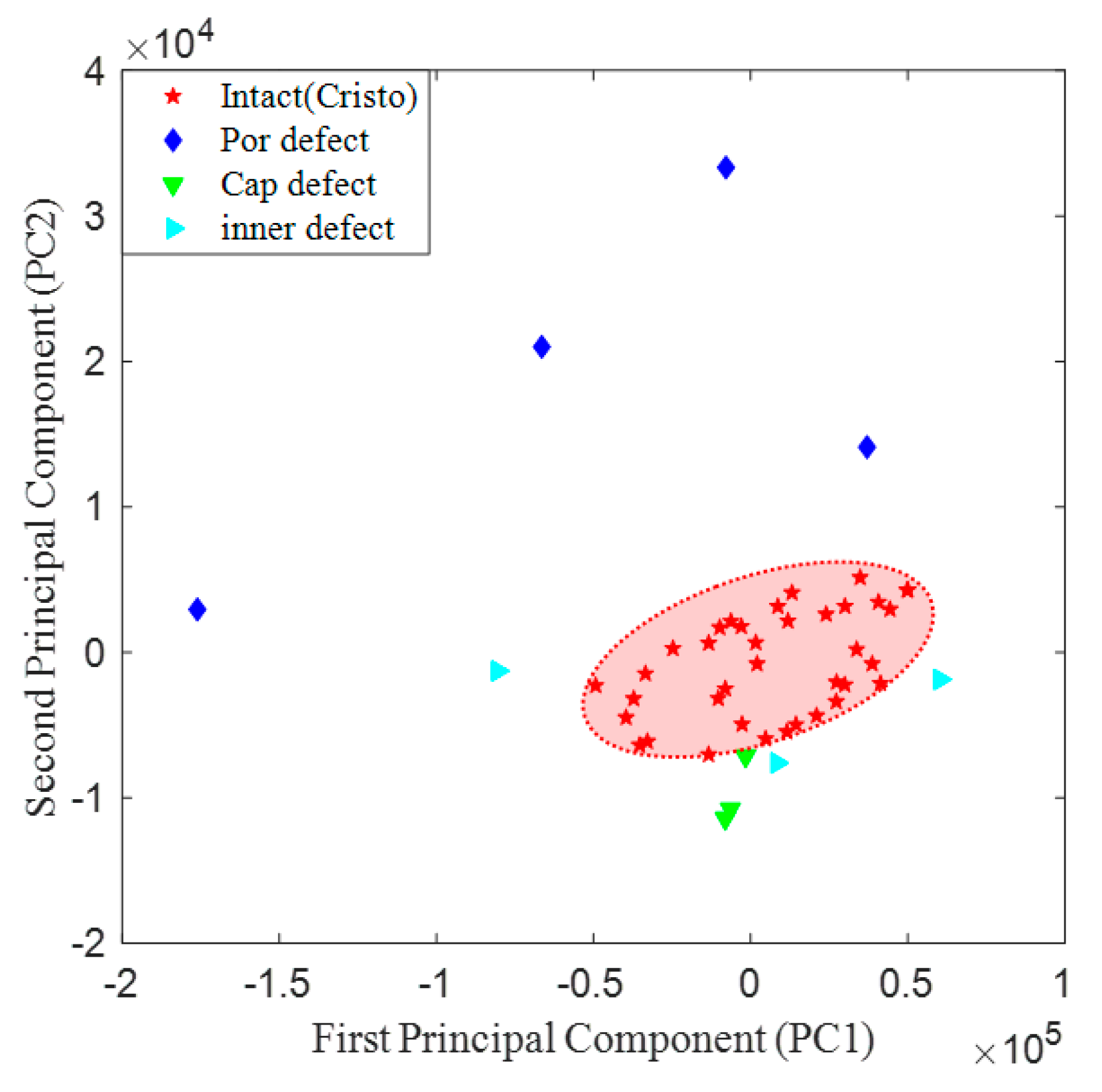

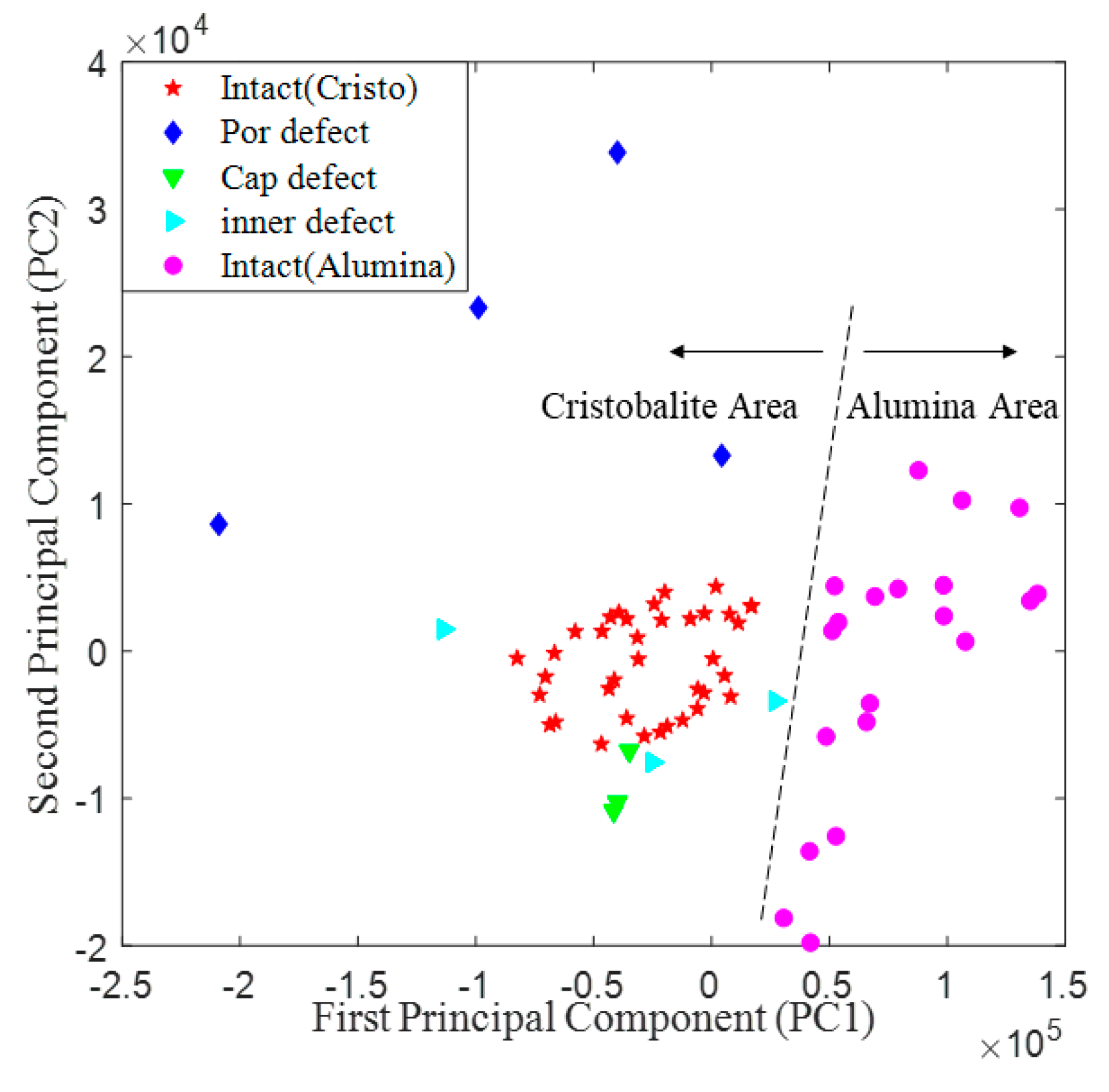
| Category | Cristobalite | Alumina | Sum | |
|---|---|---|---|---|
| Total | 47 | 20 | 67 | |
| Intact | 37 | 20 | 57 | |
| Damage type | Sub Total | 10 | - | 10 |
| Porcelain Defect | 4 | - | 4 | |
| Cap Defect | 3 | - | 3 | |
| Internal defect | 3 | - | 3 | |
| Type | Impact | Sensor |
|---|---|---|
| Type 1 | Porcelain | Cap |
| Type 2 | Porcelain | Porcelain |
| Type 3 | Cap | Cap |
| Type 4 | Cap | Porcelain |
| Mode | Cristobalite | Alumina | ||||||
|---|---|---|---|---|---|---|---|---|
| Frequency, Min | Frequency, Max | Frequency, Average | Standard Deviation | Frequency, Min | Frequency, Max | Frequency, Average | Standard Deviation | |
| 1 | 1920 | 2040 | 1986 | 28.0 | 2100 | 2180 | 2141 | 22.5 |
| 2 | 2880 | 3000 | 2937 | 31.7 | 3040 | 3140 | 3098 | 24.7 |
| 3 | 3360 | 3460 | 3408 | 32.5 | 3580 | 3660 | 3616 | 20.9 |
| 4 | 3940 | 4100 | 4022 | 43.1 | 4280 | 4420 | 4350 | 38.6 |
© 2019 by the authors. Licensee MDPI, Basel, Switzerland. This article is an open access article distributed under the terms and conditions of the Creative Commons Attribution (CC BY) license (http://creativecommons.org/licenses/by/4.0/).
Share and Cite
Choi, I.H.; Son, J.A.; Koo, J.B.; Yoon, Y.G.; Oh, T.K. Damage Assessment of Porcelain Insulators through Principal Component Analysis Associated with Frequency Response Signals. Appl. Sci. 2019, 9, 3150. https://doi.org/10.3390/app9153150
Choi IH, Son JA, Koo JB, Yoon YG, Oh TK. Damage Assessment of Porcelain Insulators through Principal Component Analysis Associated with Frequency Response Signals. Applied Sciences. 2019; 9(15):3150. https://doi.org/10.3390/app9153150
Chicago/Turabian StyleChoi, In Hyuk, Ju Am Son, Ja Bin Koo, Young Geun Yoon, and Tae Keun Oh. 2019. "Damage Assessment of Porcelain Insulators through Principal Component Analysis Associated with Frequency Response Signals" Applied Sciences 9, no. 15: 3150. https://doi.org/10.3390/app9153150
APA StyleChoi, I. H., Son, J. A., Koo, J. B., Yoon, Y. G., & Oh, T. K. (2019). Damage Assessment of Porcelain Insulators through Principal Component Analysis Associated with Frequency Response Signals. Applied Sciences, 9(15), 3150. https://doi.org/10.3390/app9153150






